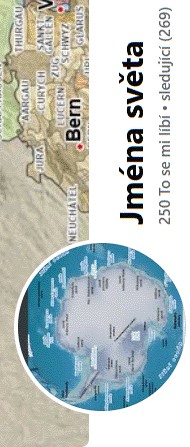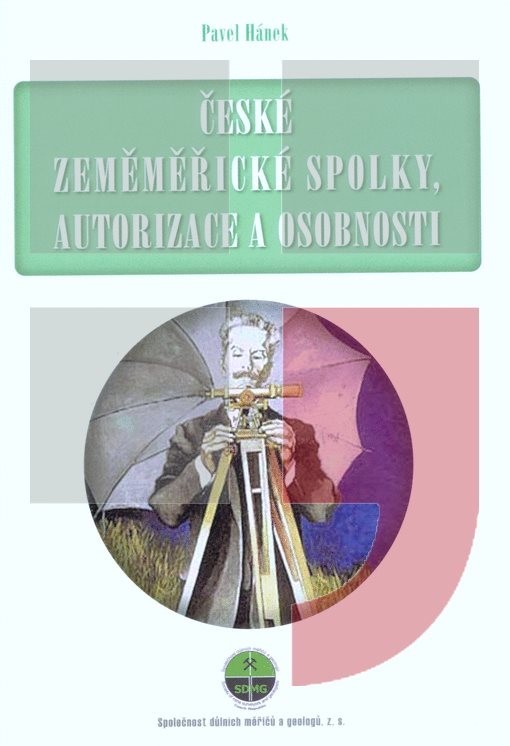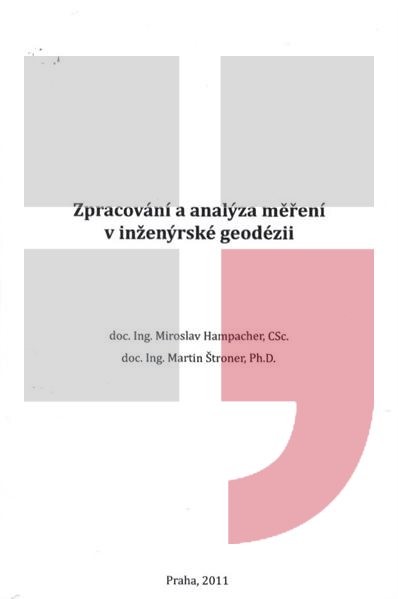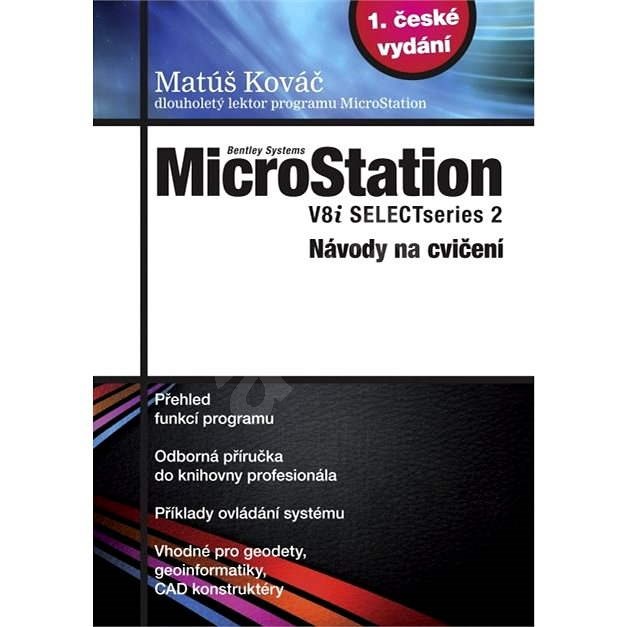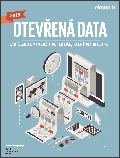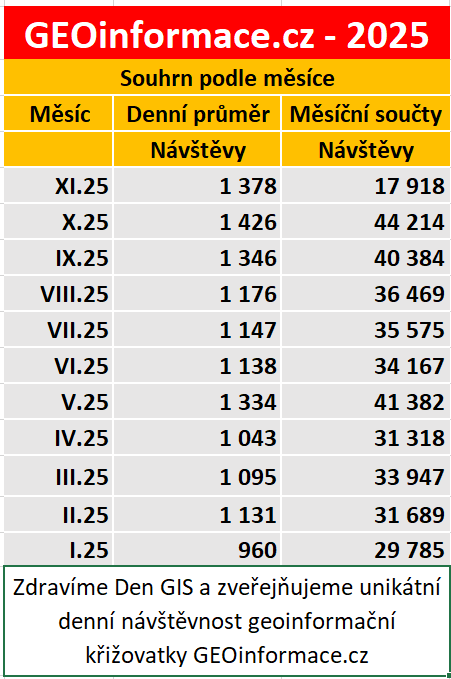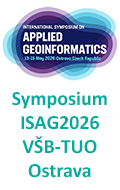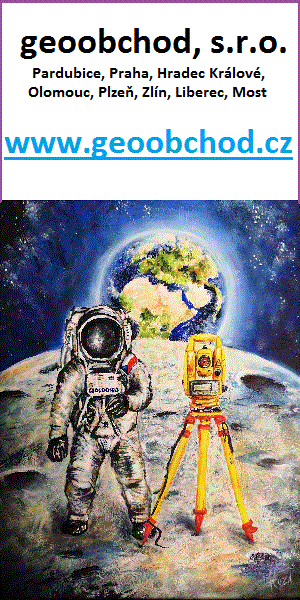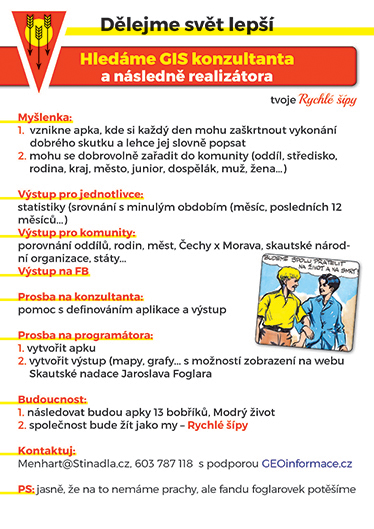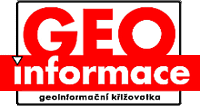zprávy
zdroje zpráv:Citadel Defense Digitizes CUAS Training for Military and Government
8.4.2021 17:31 GISCafe.com Webcasts-Webinars Titan Delivers Affordability in Force Design to Customers Around the WorldSAN DIEGO — (BUSINESS WIRE) — April 8, 2021 —
With …
Nové vedení CAGI pro období 2021-2024
8.4.2021 17:26 GISportal.cz
Dnes odpoledne proběhlo 1. zasedání nově zvoleného předsednictva CAGI, které zvolilo pro období 2021-2024 vedení CAGI: Předseda: Karel Janečka 1. místopředseda: Jiří Horák 2. místopředsedkyně: Leona Slabochová Výkonný výbor: (předseda + místopředsedové), Jan Novotný, Jiří Poláček Včera, tzn. 7. 4. 2021, proběhlo 1. zasedání nově zvolené kontrolní komise, která bude pracovat v období 2021-2024 […]
The post Nové vedení CAGI pro období 2021-2024 appeared first on GISportal.cz.
Satellites monitor Mount Etna’s unpredictable behaviour
8.4.2021 16:30 ESA Observing the Earth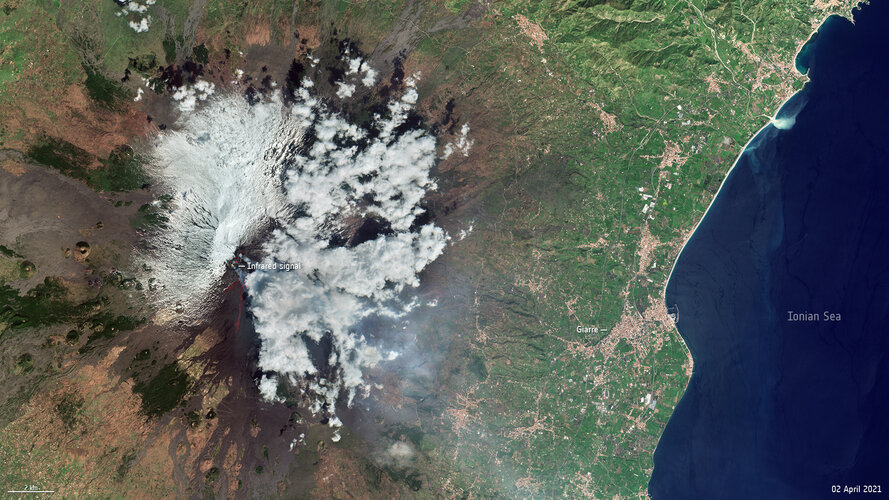
Italy’s Mount Etna, Europe’s most active volcano, has recently been on explosive form, with 17 eruptions in less than three months. Instruments onboard three different satellites orbiting Earth have acquired imagery of the eruptions – revealing the intensity of the lava-fountaining eruptive episodes, known as paroxysms.
Webinář: Tvorba mapy v ArcGIS Pro
8.4.2021 15:24 ARCDATAV úterý 13. dubna 2021 si vás dovolujeme pozvat na další vysílání webového semináře. Tentokrát se zaměříme na tvorbu map v prostředí ArcGIS Pro.
Během tohoto semináře vás od základů provedeme procesem tvorby map v ArcGIS Pro, seznámíme vás s jeho prostředím a vedle toho se podíváme i na možnosti nastavení symbolů a popisů. Ukážeme si, kde naleznete nejrůznější nástroje a funkce pro tvorbu map, a i něco trochu navíc. Mimo jiné si také zběžně představíme i některé ze středně pokročilých technik.
Pro sledování není zapotřebí instalovat žádný software, ani doplněk prohlížeče, stačí se pouze zaregistrovat na stránce webináře. Registrace i účast na semináři jsou zdarma.
Pokud vás témata jednotlivých webových seminářů zajímají, neváhejte se ptát a diskutovat s námi na Esri Community. Naleznete zde přehled všech našich chystaných i proběhlých akcí. V záložce Akce ARCDATA pravidelně odpovídáme na dotazy, které během webových seminářů zaznívají.
Odborný referent – obnova katastrálního operátu v oddělení obnovy katastrálního operátu Katastrálníh
8.4.2021 12:20 ČÚZK - předpisy a opatření Katastrální úřad pro Zlínský krajvypisuje výběrové řízení na místo
Odborný referent – obnova katastrálního operátu v oddělení obnovy katastrálního operátu Katastrálního úřadu pro Zlínský kraj
Odborný referent – obnova katastrálního operátu v oddělení obnovy katastrálního operátu Katastrálníh
8.4.2021 12:20 ČÚZK - volná místa Katastrální úřad pro Zlínský kraj vypisuje výběrové řízení na místo Odborný referent – obnova katastrálního operátu v oddělení obnovy katastrálního operátu KatastrálníhOdborný referent – obnova katastrálního operátu v oddělení obnovy katastrálního operátu Katastrálníh
8.4.2021 12:20 ČÚZK /Urady/Katastralni-urady/Katastralni-urady/Katastralni-urad-pro-Zlinsky-kraj/Uredni-deska/Oznameni-a-jina-uredni-sdeleni/Volna-mista/DMS/Odborny-referent-–-obnova-katastralniho-operatu-vInsight LiDAR Develops Industry’s First “Gesture Detection” Sensing Technology for Autonomous Vehicle LiDAR Systems
8.4.2021 0:51 GISCafe.com Webcasts-Webinars Insight 1600 Capability Enables AV Systems to Detect Small Movements Even at DistanceLAFAYETTE, Colo. — (BUSINESS WIRE) — April 7, 2021 …
Commercial UAV Expo Americas Announces Massive Early Support for 2021 Event
8.4.2021 0:51 GISCafe.com Webcasts-Webinars 225+ Best-in-class UAS partnering organizations have confirmed their support for the 2021 edition of CUAV AmericasPORTLAND, Maine, April 7, 2021 …
dataPlor expands reach with launch of APAC and EMEA regional POI datasets with over seven million verified records
8.4.2021 0:51 GISCafe.com Webcasts-Webinars dataPlor's international datasets will exceed 12 million verified records across LATAM, APAC and EMEA. The offering expands dataPlor's regional …DTM kráčí do finále (webinář)
7.4.2021 19:43 GISportal.cz
Online webinář DTM kráčí do finále – s ISTEM budete připraveni! již zítra (čtvrtek 8. dubna) od 9 do 13. DTM III. DTM kráčí do finále – s ISTEM budete připraveni! Program online semináře je připraven, prolink na Microsoft Teams aktivní. Pokud máte na nás nějaké dotazy předem, pošlete nám je na email info-cz@hexagon.com. Rádi […]
The post DTM kráčí do finále (webinář) appeared first on GISportal.cz.
Velodyne Expert Discusses How Lidar Simulations Advance Automated Driving Solutions Testing at NVIDIA GTC 2021 Global Event
7.4.2021 15:36 GISCafe.com Webcasts-Webinars Andrei Claudiu Cosma Highlights Essential Role of Lidar Simulations in Development and Validation of ADAS and AVsSAN JOSE, Calif. — (BUSINESS …
Aerial Video Takes a Big Leap Towards Real-Time Situation Awareness, Powered by Edgybees' Geo-Registration Software and HoodTech's Sensors
7.4.2021 15:36 GISCafe.com Webcasts-Webinars Real-time visual augmentation of airborne imagery with roads, key landmarks, and other mission-critical dataGAITHERSBURG, Md. and HOOD RIVER, Ore., …
Expand the Possibilities of GIS and Your Career at Johns Hokins
7.4.2021 15:29 GISCafe.com Webcasts-WebinarsSave the date: Galileo Green Lane call webinar
7.4.2021 13:03 European GNSS Agency
The European GNSS Agency (GSA) is organising a webinar on 13 April to provide information on the ‘Enhanced Galileo Green Lane - Design and Implementation’ call. Starting at 15:00 CET, the webinar will last just over an hour and will provide useful information for all parties interested in participating in this invitation to tender. For more information about the tender, click here, and to register for the webinar, click here.
The GSA and the European Commission worked together to develop the Galileo Green Lane app in April 2020 in response to the Coronavirus pandemic. The goal was to facilitate the movement of critical goods and freight within the EU in support of the COVID-19 response.
In light of the ongoing COVID-19 crisis and the interest of key institutional stakeholders, such as the International Road Transport Union (IRU), in supporting the EU freight transport community, the GSA has launched a new procurement procedure in collaboration with the European Commission.
Enhanced scope
The new procurement aims to enhance the current Galileo Green Lane solution, by extending its scope to strategic road, rail and maritime border crossings between EU Member States and neighbouring countries. Traffic and waiting times will be monitored at new points of interest for the transport community, such as national logistics hubs (including airports), service areas, refuelling stations, parking lots, etc.
Read this: Galileo Green Lane, easing pressure at the EU’s internal borders
The goal of the procurement is to design and develop the overall architecture of a mobile, telematic and/or online solution aiming at facilitating the work of freight dispatchers, road authorities and enforcers at border crossings in Europe, and to operate the developed solution.
The tenderers will be required to test their solution and operate it for the duration of the contract, which will be from six to 12 months depending on how the COVID situation evolves. The designed architecture may take advantage of EU proprietary developments, databases or techniques (e.g. geofencing algorithms) from the previous Galileo Green Lane platform.
Submitting a successful proposal
The webinar on 13 April will provide an overview of the call priorities and explain the framework and objectives of the procurement. It will also be an opportunity for interested stakeholders and applicants to learn how to prepare a successful proposal. For more information, click here.
Media note: This feature can be republished without charge provided the European GNSS Agency (GSA) is acknowledged as the source at the top or the bottom of the story. You must request permission before you use any of the photographs on the site. If you republish, we would be grateful if you could link back to the GSA website (http://www.gsa.europa.eu).
Save the date: Galileo Green Lane call webinar
7.4.2021 13:03 European GNSS Agency
The European GNSS Agency (GSA) is organising a webinar on 13 April to provide information on the ‘Enhanced Galileo Green Lane - Design and Implementation’ call. Starting at 15:00 CET, the webinar will last just over an hour and will provide useful information for all parties interested in participating in this invitation to tender. For more information about the tender, click here, and to register for the webinar, click here.
The GSA and the European Commission worked together to develop the Galileo Green Lane app in April 2020 in response to the Coronavirus pandemic. The goal was to facilitate the movement of critical goods and freight within the EU in support of the COVID-19 response.
In light of the ongoing COVID-19 crisis and the interest of key institutional stakeholders, such as the International Road Transport Union (IRU), in supporting the EU freight transport community, the GSA has launched a new procurement procedure in collaboration with the European Commission.
Enhanced scope
The new procurement aims to enhance the current Galileo Green Lane solution, by extending its scope to strategic road, rail and maritime border crossings between EU Member States and neighbouring countries. Traffic and waiting times will be monitored at new points of interest for the transport community, such as national logistics hubs (including airports), service areas, refuelling stations, parking lots, etc.
Read this: Galileo Green Lane, easing pressure at the EU’s internal borders
The goal of the procurement is to design and develop the overall architecture of a mobile, telematic and/or online solution aiming at facilitating the work of freight dispatchers, road authorities and enforcers at border crossings in Europe, and to operate the developed solution.
The tenderers will be required to test their solution and operate it for the duration of the contract, which will be from six to 12 months depending on how the COVID situation evolves. The designed architecture may take advantage of EU proprietary developments, databases or techniques (e.g. geofencing algorithms) from the previous Galileo Green Lane platform.
Submitting a successful proposal
The webinar on 13 April will provide an overview of the call priorities and explain the framework and objectives of the procurement. It will also be an opportunity for interested stakeholders and applicants to learn how to prepare a successful proposal. For more information, click here.
Media note: This feature can be republished without charge provided the European GNSS Agency (GSA) is acknowledged as the source at the top or the bottom of the story. You must request permission before you use any of the photographs on the site. If you republish, we would be grateful if you could link back to the GSA website (http://www.gsa.europa.eu).
Z důvodu změny WMS služby &quo
7.4.2021 12:33 GEUSware Z důvodu změny WMS služby "Bodové pole" přestaly v programech GEUS fungovat některé funkce (mapové služby WMS - rastr bodové pole, geodetické údaje přes WMS, kontrola bodů přes WMS), které tuto službu využívají. Usilovně pracujeme na zapracování těchto změn do programu a vydání nového sestavení programu GEUS 25.0.Podrobnosti k českým webinářům o softwaru ArcGIS Pro
7.4.2021 11:52 GeoBusinessFirma Arcdata Praha pořádá sérii webinářů, věnovanou softwaru Esri ArcGIS Pro. Každý ze seminářů trvá přibližně 45 minut a pro registrované účastníky bude k dispozici záznam setkání. V původní verzi článku byly uvedeny také odkazy na jednotlivé registrační formuláře, ale protože služba, kterou si organizátoři webináře vybrali, po ukončení akce registrační stránku smaže, tak jsme […]
The post Podrobnosti k českým webinářům o softwaru ArcGIS Pro appeared first on GeoBusiness.
Podrobnosti k českým webinářům o softwaru ArcGIS Pro
7.4.2021 11:52 GeoBusinessFirma Arcdata Praha pořádá sérii webinářů, věnovanou softwaru Esri ArcGIS Pro. Každý ze seminářů trvá přibližně 45 minut a pro registrované účastníky bude k dispozici záznam setkání. Přechod na ArcGIS Pro Přednášející: Vladimír Zenkl Datum: 30. března 2021, 10 – 10:45 hod. Na praktických ukázkách si předvedeme, jak základní postupy a úlohy, které jste byli […]
The post Podrobnosti k českým webinářům o softwaru ArcGIS Pro appeared first on GeoBusiness.
Zrušení sběrného boxu (schránky)
7.4.2021 11:02 ČÚZK - předpisy a opatření Katastrální úřad pro Moravskoslezský kraj - Katastrální pracoviště Karviná zveřejnil novou aktualitu: Zrušení sběrného boxu (schránky)V souvislosti s koncem nouzového stavu bude na Katastrálním pracovišti Karviná s účinností od 12. 4. 2021 zrušena možnost bezkontaktního podání prostřednictvím sběrného boxu (schránky).
Děkujeme za pochopení.
Zrušení sběrného boxu (schránky)
7.4.2021 11:02 ČÚZK /Urady/Katastralni-urady/Katastralni-urady/Katastralni-urad-pro-Moravskoslezsky-kraj/Katastralni-pracoviste/KP-Karvina/O-uradu/Aktuality/Zruseni-sberneho-boxu-(schranky)Jak nasadit ArcGIS na celé město?
7.4.2021 10:52 blog ARCDATA Nasadit GIS tak, aby se opravdu stal systémem pro celý městský úřad, nemusí být ve skutečnosti tak jednoduché, jak se může na první pohled zdát. Přiblížíme vám proto, jak s tímto nelehkým úkolem může pomoci koncept neomezené multilicence.07042021- Přehled přestupků 2020
7.4.2021 8:29 ČÚZK - aktuality v resortu V souladu s § 110 zákona č. 250/2016 Sb., o odpovědnosti za přestupky a řízení o nich, byl zveřejněn přehled přestupků za rok 2020.07042021- Přehled přestupků 2020
7.4.2021 8:29 ČÚZK /Aktuality-resort/2021/07042021-Prehled-prestupku-202007042021- Přehled přestupků 2020
7.4.2021 8:29 ČÚZK - předpisy a opatření Český úřad zeměměřický a katastrální zveřejnil novou aktualitu: V souladu s § 110 zákona č. 250/2016 Sb., o odpovědnosti za přestupky a řízení o nich, byl zveřejněn přehled přestupků za rok 2020.OmniSci Announces Multiple Opportunities To Accelerate Geospatial, GPU Database Knowledge At GTC 2021, April 12-16
7.4.2021 0:34 GISCafe.com Webcasts-Webinars Accelerated Analytics Provider will Conduct Three Seminars Plus One-On-One Meetings With Company Experts; Free, Full-Featured Version of OmniSci Now …Executive Director University Consortium for Geographic Information Science (UCGIS)
6.4.2021 20:57 Note: This is a part-time (20 hours/week, 12 months/year) and remote working position Do you have a background in GIS in higher education, government, or industry? Do you have experience in program or organizational administration? Are you a self-starter, team-player, and creative thinker who enjoys making new social and professional connections? Are you eager to do […]EagleView Welcomes Tad Finer as Chief Revenue Officer
6.4.2021 17:08 GISCafe.com Webcasts-Webinars BELLEVUE, Wash., April 06, 2021 (GLOBE NEWSWIRE) -- EagleView, a leading geospatial technology provider of software, aerial imagery and analytics, …Innoviz Expands Board of Directors with Global Technology and Automotive Industry Veterans
6.4.2021 17:08 GISCafe.com Webcasts-Webinars The Newly Appointed Board Members Will Support Innoviz in Deploying its Automotive-Grade LiDAR Product Line Globally and Accelerating Safe and …Odborný referent / vrchní referent – kontrola aktualizace v oddělení právních vztahů k nemovitostem
6.4.2021 17:07 ČÚZK - předpisy a opatření Katastrální úřad pro Zlínský kraj Katastrální pracoviště Zlínvypisuje výběrové řízení na místo
Odborný referent / vrchní referent – kontrola aktualizace v oddělení právních vztahů k nemovitostem Katastrálního pracoviště Zlín
Odborný referent / vrchní referent – kontrola aktualizace v oddělení právních vztahů k nemovitostem
6.4.2021 17:07 ČÚZK - volná místa Katastrální úřad pro Zlínský kraj Katastrální pracoviště Zlín vypisuje výběrové řízení na místo Odborný referent / vrchní referent – kontrola aktualizace v oddělení právních vztahů k nemovitostemOdborný referent / vrchní referent – kontrola aktualizace v oddělení právních vztahů k nemovitostem
6.4.2021 17:07 ČÚZK /Urady/Katastralni-urady/Katastralni-urady/Katastralni-urad-pro-Zlinsky-kraj/Uredni-deska/Oznameni-a-jina-uredni-sdeleni/Volna-mista/DMS/Odborny-referent-vrchni-referent-–-kontrola-aktuDěčín na svém mapovém portálu nabízí aplikaci Školské obvody
6.4.2021 16:59 T-MAPYThe post Děčín na svém mapovém portálu nabízí aplikaci Školské obvody appeared first on T-MAPY spol. s r.o..
Kurz: Jak pomocí ArcGIS vytvořit vlastní aplikaci?
6.4.2021 15:48 ARCDATANejste zrovna softwarový vývojář, ale rádi byste vytvářeli vlastní aplikace, které obsahují mapy a využívají geoprostorové nástroje? V online kurzu od Esri se naučíte, jak kombinovat prostorové informace v jedné aplikaci. Pokud vás zajímá, co vše se můžete v kurzu naučit, podívejte se na sylabus jednotlivých lekcí.
Kurz je zcela zdarma, stačí se pouze registrovat. Výuka začíná již ve čtvrtek 8. dubna 2021.
Účastníci v rámci kurzu získají volný přístup k ArcGIS Online a všem potřebným aplikacím. Po celou dobu konání kurzu budou mít rovněž přístup ke studijním materiálům a cvičením a po dokončení kurzu pak obdrží certifikát.
Na kurz se můžete přihlásit na webových stránkách Esri.

Omezení provozu KP Vyškov - 14. 04. 2021
6.4.2021 14:31 ČÚZK - předpisy a opatření Katastrální úřad pro Jihomoravský kraj zveřejnil novou aktualitu: Omezení provozu KP Vyškov - 14. 04. 2021V důsledku přerušení dodávky elektřiny bude provoz KP Vyškov dne 14. 04. 2021 (v době od 7:30 do 15:00h) omezen.
Omezení provozu KP Vyškov - 14. 04. 2021
6.4.2021 14:31 ČÚZK /Urady/Katastralni-urady/Katastralni-urady/Katastralni-urad-pro-Jihomoravsky-kraj/Katastralni-pracoviste/KP-Vyskov/O-uradu/Aktuality/Omezeni-provozu-KP-Vyskov-14-04-2021GSA congratulates Search and Rescue teams on #406Day2021
6.4.2021 12:34 European GNSS Agency
Beacon Awareness Day (#406Day) on April 6 is an opportunity to celebrate the amazing work carried out by Search and Rescue teams around the world that risk their lives on a daily basis to save people in distress. It also aims to remind the owners of Search and Rescue beacons the need to register their beacon and test them in a regular basis, in particular for what concerns their batteries and, for those already registered, to update their Cospas-Sarsat contact details.
On #406Day2021, we celebrate Search and Rescue teams all around the world. But why 406? Well, 406 Day, as April 6th is written in the US where the initiative emerged, is a reference to the 406 MHz frequency of the Search and Rescue beacons used by the international rescue organisation Cospas-Sarsat. These beacons help save an average of seven lives every day around the world.
The Galileo SAR service is Europe’s contribution to Cospas-Sarsat and, as of January 2020, Galileo provides also the system with a unique feature – its Return Link Service. The Return Link provides the transmitting distress beacon with acknowledgement that the distress signal has been received, its position has been determined and that rescue teams are alerted. This is a major morale booster for the people calling for assistance and, so far, Galileo is the only GNSS to offer such a service to end users.
Unique feature
“Galileo’s Return Link Service is a unique feature that is a perfect example of the GSA’s core mission of linking space to user needs. It is a great European Union achievement. The GSA has also been supporting the development of beacons that are Return Link enabled, in an effort to facilitate the work of the Search and Rescue services, whose generous work we celebrate today,” said GSA Executive Director Rodrigo da Costa.
Read this: Standard published for remote activation of aircraft distress tracking beacons using Galileo RLS
The GSA and its partners – the European Commission, ESA, and CNES - are proud to provide Europe’s contribution to Cospas-Sarsat by placing the Galileo constellation at the disposal of Search and Rescue teams. In just over a year, the last Cospas-Sarsat Council endorsed the Galileo Return Link functionality, allowing the service to finalise the transition to Return Link Service Full Operational 24/7 and global Capacity.
Galileo will continue to provide rescue teams with the best tools possible. To ensure this, consultations are carried out with operational Search and Rescue units to collect their views and expectations, so that the next evolutions of the Galileo SAR will match their operational needs as closely as possible, allowing them to save even more lives in the future.
Media note: This feature can be republished without charge provided the European GNSS Agency (GSA) is acknowledged as the source at the top or the bottom of the story. You must request permission before you use any of the photographs on the site. If you republish, we would be grateful if you could link back to the GSA website (http://www.gsa.europa.eu).
406 Day: celebrating Galileo saving lives
6.4.2021 12:30 ESA Navigation
Today is 406 Day – the annual campaigning day to spread awareness of the importance of emergency beacons, and the satellites that pick up their signals, including Europe’s Galileo constellation. As well as letting people across the world find their way, Galileo also serves to detect SOS messages and relay them to authorities, contributing to saving many lives.
20210406_Odborný referent / vrchní referent oddělení obnovy katastrálního operátu 03110
6.4.2021 8:55 ČÚZK - předpisy a opatření Katastrální úřad pro Středočeský kraj Vyhlášení výběrového řízení: Odborný referent / vrchní referent oddělení obnovy katastrálního operátu 03110 V části "Úřední deska", v sekci "Oznámení a jiná úřední sdělení" bylo vystaveno "Oznámení o vyhlášení výběrového řízení na obsazení služebního místa Odborný referent / vrchní referent oddělení obnovy katastrálního operátu 03110"20210406_Odborný referent / vrchní referent oddělení obnovy katastrálního operátu 03110
6.4.2021 8:55 ČÚZK /Urady/Katastralni-urady/Katastralni-urady/Katastralni-urad-pro-Stredocesky-kraj/O-uradu/Aktuality/20210106_Odborny-vrchni-referent-oddeleni-aktu-(1)Odborný referent / vrchní referent oddělení obnovy katastrálního operátu 03110
6.4.2021 8:54 ČÚZK - volná místa Katastrální úřad pro Středočeský kraj - technická sekce vypisuje výběrové řízení na místo Odborný referent / vrchní referent oddělení obnovy katastrálního operátu 03110Odborný referent / vrchní referent oddělení obnovy katastrálního operátu 03110
6.4.2021 8:54 ČÚZK /Urady/Katastralni-urady/Katastralni-urady/Katastralni-urad-pro-Stredocesky-kraj/Uredni-deska/Oznameni-a-jina-uredni-sdeleni/Volna-mista/Odborny-referent-vrchni-referent-oddeleni-obnovyOdborný referent / vrchní referent oddělení obnovy katastrálního operátu 03110
6.4.2021 8:54 ČÚZK - předpisy a opatření Katastrální úřad pro Středočeský kraj - technická sekcevypisuje výběrové řízení na místo Odborný referent / vrchní referent oddělení obnovy katastrálního operátu 03110
Odborný referent / vrchní referent oddělení obnovy katastrálního operátu 03110
Amazon Web Services Becomes USGIF Strategic-Level Member
6.4.2021 4:06 GISCafe.com Webcasts-Webinars USGIF welcomes Amazon Web Services to its growing list of organizational members. Herndon, Virginia (April 5, 2021)—The United …
Kratos XQ-58A Valkyrie Successfully Completes Sixth Flight, Including First Payload Release from Internal Weapons Bay
6.4.2021 2:28 GISCafe.com Webcasts-Webinars SAN DIEGO, April 05, 2021 (GLOBE NEWSWIRE) -- Kratos Defense & Security Solutions, Inc. (NASDAQ:KTOS), a leading National Security Solutions …K dispozici je servicepack SP3
6.4.2021 0:00 SolidVision K dispozici je servicepack SP3 pro SOLIDWORKS 2021. Uživatelé s aktivní předplacenou údržbou si mohou nejaktuálnější servicepack stáhnout na Zákaznickém portále SOLIDWORKS.K dispozici je servicepack SP3
6.4.2021 0:00 SolidVision K dispozici je servicepack SP3 pro SOLIDWORKS 2021. Uživatelé s aktivní předplacenou údržbou si mohou nejaktuálnější servicepack stáhnout na Zákaznickém portále SOLIDWORKS.SkyTask, Inc. Announces FAA Waiver Approval for BVLOS Remote Flight Operations at Colorado State University Drone Center
5.4.2021 19:18 GISCafe.com Webcasts-Webinars DENVER — (BUSINESS WIRE) — April 5, 2021 —Remote UAV Flight Operations company SkyTask, Inc. announced today that it received its …
Knightscope Selects Velodyne Lidar Technology for Next-Generation Autonomous Security Solutions
5.4.2021 16:09 GISCafe.com Webcasts-Webinars Autonomous Security Robot Developer Begins Defining Its 5th Generation TechnologyMOUNTAIN VIEW, Calif. — (BUSINESS WIRE) — April 5, 2021 …
Kratos Wins $86 Million, Assuming All Options Exercised, Single Award U.S. Army Contract for Drone Command and Control Systems
5.4.2021 16:09 GISCafe.com Webcasts-Webinars SAN DIEGO, April 05, 2021 (GLOBE NEWSWIRE) -- Kratos Defense & Security Solutions, Inc. (NASDAQ: KTOS), a leading National Security …Innoviz Technologies and Collective Growth Corporation Announce Closing of Business Combination
5.4.2021 16:09 GISCafe.com Webcasts-Webinars TEL AVIV, Israel and AUSTIN, Texas, April 5, 2021 — (PRNewswire) — Innoviz Technologies, a technology leader of high-performance, …Na webových stránkách naší spo
5.4.2021 0:00 SolidVision Na webových stránkách naší společnosti je v sekci Podpora > Ke stažení k dispozici SP2 pro SOLIDWORKS 2021.Na webových stránkách naší spo
5.4.2021 0:00 SolidVision Na webových stránkách naší společnosti je v sekci Podpora > Ke stažení k dispozici SP2 pro SOLIDWORKS 2021.ProStar Poised to Disrupt the Infrastructure Industry with the Release of a Revolutionary Technology
2.4.2021 20:43 GISCafe.com Webcasts-Webinars GRAND JUNCTION, Colo., March 31, 2021 — (PRNewswire) — ProStar Holdings Inc ("ProStar®" or the "Company") (TSXV: MAPS) (FSE: …senseFly and Tough Stump Collaboration Signals New Era in UAS Tactical Mapping, Aerial Intelligence
2.4.2021 19:57 GISCafe.com Webcasts-Webinars CHESEAUX-SUR-LAUSANNE, Switzerland, 16th March 2021 – senseFly, the global leader in fixed-wing mapping drones, has announced a new …How Have Health Care Experts Used Geospatial Technology During the Pandemic? Drs. Este Geraghty of Esri & Alexander Garza of SSMHealth will discuss @ April 7 GeoInnovation Speaker Series
2.4.2021 19:29 GISCafe.com Webcasts-Webinars April GeoInnovation National Geospatial Speaker Series to Highlight Use of Geospatial Technology to Address Challenges During the …April GeoInnovation National Geospatial Speaker Series to Highlight Use of Geospatial Technology to Address Challenges During the Pandemic
2.4.2021 19:29 GISCafe.com Webcasts-Webinars Discussion will feature Dr. Este Geraghty, CMO of Esri, be moderated by Dr. Alexander Garza of St. Louis Metropolitan Pandemic Task …Earth from Space: Easter egg hunt
2.4.2021 10:00 ESA Observing the Earth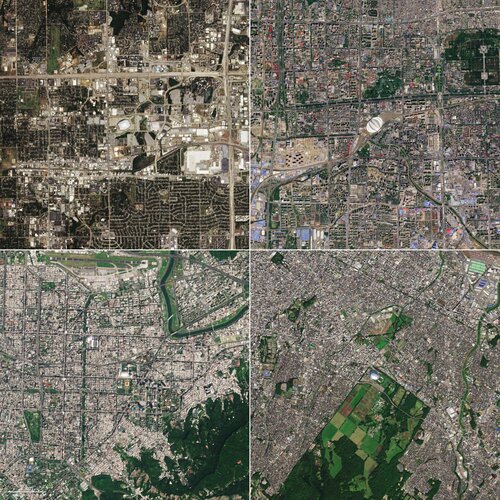
With Easter right around the corner, we take a look at four egg-shaped buildings visible from space as captured by the Copernicus Sentinel-2 mission.
DOTAZNÍK DRONY
2.4.2021 9:45 UAVADOTAZNÍK DRONY Aliance pro bezpilotní letecký průmysl spouští dotazník k průzkumu aktuálního povědomí české veřejnosti k dronům. Prosíme o vyplnění a sdílení dotazníku, obzvlášť i mezi ostatní co nemají drony, pro co největší účast a různorodost respondentů. Odpovídejte prosím do 12.4.2021, poté bude dotazník uzavřen. Vyplnění dotazníku nezabere více než 3 minuty a výsledky budou […]
The post DOTAZNÍK DRONY appeared first on UAV Aliance pro bezpilotní letecký průmysl.
New Chair of knowledge exchange expert group aims to INSPIRE development of European Spatial Data Infrastructure
2.4.2021 9:00 GISCafe.com Webcasts-Webinars March 29, 2021 -- Marcin Grudzień from the Head Office of Geodesy and Cartography (GUGIK) in Poland has been named the new Chair of a European …Cesium Releases Free 'Cesium for Unreal' for All Creators
2.4.2021 9:00 GISCafe.com Webcasts-Webinars Open source plugin unlocks global 3D data and geospatial technology for Unreal Engine and is now available for free on Epic Games' Unreal Engine …Drony (dotazník)
2.4.2021 8:34 GISportal.cz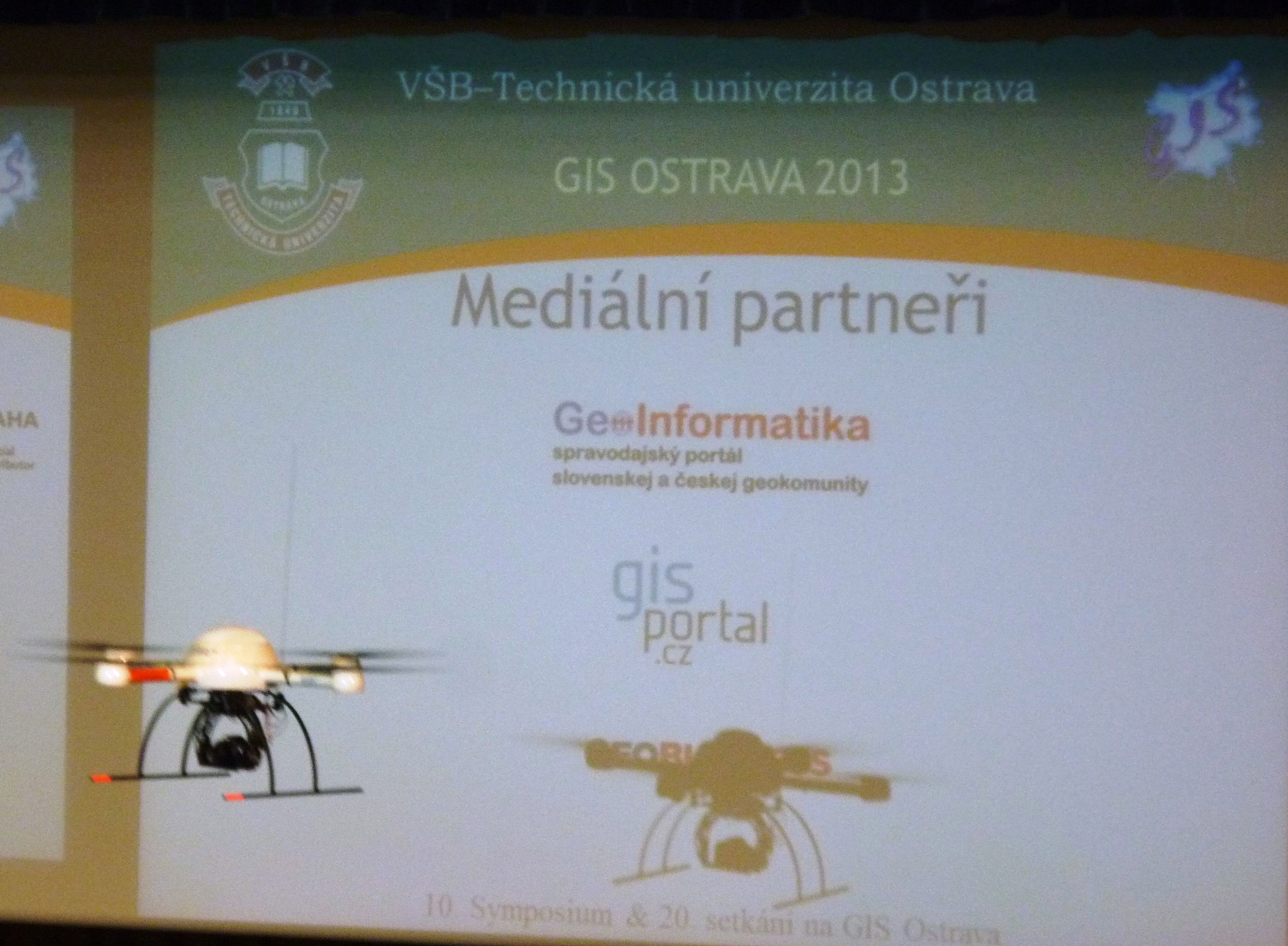
Aliance pro bezpilotní letecký průmysl (UAVA) prosí o vyplnění krátkého anonymního dotazníku pro průzkum k tématu dronů. Dotazník zabere maximálně 3 minuty času, prosíme o vyplnění do 12. 4. 2021, kdy bude průzkum uzavřen.
The post Drony (dotazník) appeared first on GISportal.cz.
Teledyne Clears Canada and Germany Antitrust Reviews for the FLIR Acquisition
2.4.2021 1:46 GISCafe.com Webcasts-Webinars THOUSAND OAKS, Calif. — (BUSINESS WIRE) — April 1, 2021 —Teledyne Technologies Incorporated (NYSE:TDY) announced today that it …
NGA Accelerator Announces Startups for Inaugural Cohort
1.4.2021 20:21 GISCafe.com Webcasts-Webinars The NGA Accelerator Powered by Capital Innovators recently selected eight companies to participate in the launch of the inaugural cohort of its …ÚCL zveřejnilo postupy a dokumenty k oprávnění provozu ve Specifické kategorii
1.4.2021 19:39 UAVAÚřad pro civilní letectví zveřejnil postupy včetně dokumentů potřebných k vydání Oprávnění k provozu ve Specifické kategorii, jehož platnost bude dvouletá. ÚCL doporučuje využít nyní provozovatelům s prodlouženou platností Leteckých prací (do konce roku 2021) plynulý přechod do Specifické kategorie a současně úpravu schválené provozní příručky do šablony dokumentu ConOps . Více zde: https://www.caa.cz/provoz/bezpilotni-letadla/specificka-kategorie-specific/postupy-a-formulare-dokumentu-k-agende-opravneni-k-provozu/
The post ÚCL zveřejnilo postupy a dokumenty k oprávnění provozu ve Specifické kategorii appeared first on UAV Aliance pro bezpilotní letecký průmysl.
Applications of Location-Based & Geospatial Intelligence Data
1.4.2021 16:23 GISCafe.com Webcasts-Webinars NEW YORK, April 1, 2021 — (PRNewswire) — Enterprises, government agencies, and law enforcement use Cobwebs Technologies' …Hexagon publishes the Annual Report and Sustainability Report 2020
1.4.2021 16:23 GISCafe.com Webcasts-Webinars STOCKHOLM, April 1, 2021 — (PRNewswire) — Hexagon's Annual Report 2020 and separate Sustainability Report is now available at Hexagon's …Velodyne Lidar Announces Multi-Year Agreement With AGM Systems LLC
1.4.2021 16:23 GISCafe.com Webcasts-Webinars AGM Systems Launches New Velodyne Lidar-Based UAV Mapping Solution for Leading Energy Companies WorldwideSAN JOSE, Calif. — (BUSINESS WIRE) …
Trimble Releases 2020 Sustainability Report
1.4.2021 16:23 GISCafe.com Webcasts-Webinars SUNNYVALE, Calif., April 1, 2021 — (PRNewswire) — Trimble (NASDAQ: TRMB) announced today the release of its 2020 Sustainability Report. …Trimble and Florida International University Establish Trimble Technology Lab at the Moss School of Construction, Infrastructure and Sustainability
1.4.2021 16:23 GISCafe.com Webcasts-Webinars SUNNYVALE, Calif. and MIAMI, April 1, 2021 — (PRNewswire) — Building on a commitment to cultivate a highly-trained workforce that …Dynamic Infrastructure to Reveal Major Technological Breakthrough of Drone (UAS) Photos Analysis Captured While Inspecting Bridges
1.4.2021 16:23 GISCafe.com Webcasts-Webinars NEW YORK and BERLIN, April 1, 2021 — (PRNewswire) — Automatic processing of drone photos according to AASHTO standards while …Úřední hodiny od 12.4.2021
1.4.2021 11:52 ČÚZK - předpisy a opatření Katastrální úřad pro Moravskoslezský kraj - Katastrální pracoviště Třinec zveřejnil novou aktualitu: ÚPRAVA ÚŘEDNÍCH HODINS účinností od 12. 4. 2021 je na Katastrálním pracovišti Třinec provedena změna úředních hodin.
Úřední hodiny jsou pro všechny agendy:
pondělí a středa 8:00 – 17:00 hodin,
úterý a čtvrtek 8:00 – 14:00 hodin,
pátek 8:00 – 12:00 hodin.
I nadále upřednostňujeme bezkontaktní způsob podání (poštou, elektronicky). Při osobním kontaktu Vás žádáme o dodržování hygienických zásad a respektování pokynů našich zaměstnanců.
Sběrný box na budově úřadu bude zavedením rozšířených úředních hodin zrušen.
Děkujeme za pochopení.
Úřední hodiny od 12.4.2021
1.4.2021 11:48 ČÚZK /Urady/Katastralni-urady/Katastralni-urady/Katastralni-urad-pro-Moravskoslezsky-kraj/Katastralni-pracoviste/KP-Ostrava/O-uradu/Aktuality/Uredni-hodiny-od-12-4-2021Úřední hodiny od 12.4.2021
1.4.2021 11:48 ČÚZK - předpisy a opatření Katastrální úřad pro Moravskoslezský kraj - Katastrální pracoviště Ostrava zveřejnil novou aktualitu: ÚPRAVA ÚŘEDNÍCH HODINS účinností od 12. 4. 2021 je na Katastrálním pracovišti Ostrava provedena změna úředních hodin.
Úřední hodiny jsou pro všechny agendy:
pondělí a středa 8:00 – 17:00 hodin,
úterý a čtvrtek 8:00 – 14:00 hodin,
pátek 8:00 – 12:00 hodin.
I nadále upřednostňujeme bezkontaktní způsob podání (poštou, elektronicky). Při osobním kontaktu Vás žádáme o dodržování hygienických zásad a respektování pokynů našich zaměstnanců.
Sběrný box na vstupních dveřích úřadu bude zavedením rozšířených úředních hodin zrušen.
Děkujeme za pochopení.
Úřední hodiny od 12.4.2021
1.4.2021 11:40 ČÚZK - předpisy a opatření Katastrální úřad pro Moravskoslezský kraj - Katastrální pracoviště Frýdek-Místek zveřejnil novou aktualitu: ÚPRAVA ÚŘEDNÍCH HODINS účinností od 12. 4. 2021 je na Katastrálním pracovišti Frýdek-Místek provedena změna úředních hodin.
Úřední hodiny jsou pro všechny agendy:
pondělí a středa 8:00 – 17:00 hodin,
úterý a čtvrtek 8:00 – 14:00 hodin,
pátek 8:00 – 12:00 hodin.
I nadále upřednostňujeme bezkontaktní způsob podání (poštou, elektronicky). Při osobním kontaktu Vás žádáme o dodržování hygienických zásad a respektování pokynů našich zaměstnanců.
Sběrný box na budově úřadu bude zavedením rozšířených úředních hodin zrušen.
Děkujeme za pochopení.
Úřední hodiny od 8.4.2021
1.4.2021 11:31 ČÚZK /Urady/Katastralni-urady/Katastralni-urady/Katastralni-urad-pro-Moravskoslezsky-kraj/Katastralni-pracoviste/KP-Opava/O-uradu/Aktuality/Uredni-hodiny-od-8-4-2021Úřední hodiny od 8.4.2021
1.4.2021 11:31 ČÚZK - předpisy a opatření Katastrální úřad pro Moravskoslezský kraj - Katastrální pracoviště Opava zveřejnil novou aktualitu: ÚPRAVA ÚŘEDNÍCH HODINS účinností od 8. 4. 2021 je na Katastrálním pracovišti Opava provedena změna úředních hodin.
Úřední hodiny jsou pro všechny agendy:
pondělí a středa 8:00 – 17:00 hodin,
úterý a čtvrtek 8:00 – 14:00 hodin,
pátek 8:00 – 12:00 hodin.
I nadále upřednostňujeme bezkontaktní způsob podání (poštou, elektronicky). Při osobním kontaktu Vás žádáme o dodržování hygienických zásad a respektování pokynů našich zaměstnanců.
Sběrný box na budově úřadu bude zavedením rozšířených úředních hodin zrušen.
Děkujeme za pochopení.
Úřední hodiny od 8.4.2021
1.4.2021 11:28 ČÚZK /Urady/Katastralni-urady/Katastralni-urady/Katastralni-urad-pro-Moravskoslezsky-kraj/Katastralni-pracoviste/KP-Novy-Jicin/O-uradu/Aktuality/Uredni-hodiny-od-8-4-2021Úřední hodiny od 8.4.2021
1.4.2021 11:28 ČÚZK - předpisy a opatření Katastrální úřad pro Moravskoslezský kraj - Katastrální pracoviště Nový Jičín zveřejnil novou aktualitu: ÚPRAVA ÚŘEDNÍCH HODINS účinností od 8. 4. 2021 je na Katastrálním pracovišti Nový Jičín provedena změna úředních hodin.
Úřední hodiny jsou pro všechny agendy:
pondělí a středa 8:00 – 17:00 hodin,
úterý a čtvrtek 8:00 – 14:00 hodin,
pátek 8:00 – 12:00 hodin.
I nadále upřednostňujeme bezkontaktní způsob podání (poštou, elektronicky). Při osobním kontaktu Vás žádáme o dodržování hygienických zásad a respektování pokynů našich zaměstnanců.
Děkujeme za pochopení.
Úřední hodiny od 8.4.2021
1.4.2021 11:23 ČÚZK - předpisy a opatření Katastrální úřad pro Moravskoslezský kraj - Katastrální pracoviště Krnov zveřejnil novou aktualitu: ÚPRAVA ÚŘEDNÍCH HODINS účinností od 8. 4. 2021 je na Katastrálním pracovišti Krnov provedena změna úředních hodin.
Úřední hodiny jsou pro všechny agendy:
pondělí a středa 8:00 – 17:00 hodin,
úterý a čtvrtek 8:00 – 14:00 hodin,
pátek 8:00 – 12:00 hodin.
I nadále upřednostňujeme bezkontaktní způsob podání (poštou, elektronicky). Při osobním kontaktu Vás žádáme o dodržování hygienických zásad a respektování pokynů našich zaměstnanců.
Děkujeme za pochopení.
Úřední hodiny od 8.4.2021
1.4.2021 11:23 ČÚZK /Urady/Katastralni-urady/Katastralni-urady/Katastralni-urad-pro-Moravskoslezsky-kraj/Katastralni-pracoviste/KP-Krnov/O-uradu/Aktuality/Uredni-hodiny-od-8-4-2021Úřední hodiny od 8.4.2021
1.4.2021 11:19 ČÚZK /Urady/Katastralni-urady/Katastralni-urady/Katastralni-urad-pro-Moravskoslezsky-kraj/Katastralni-pracoviste/KP-Karvina/O-uradu/Aktuality/Uredni-hodiny-od-8-4-2021Úřední hodiny od 8.4.2021
1.4.2021 11:19 ČÚZK - předpisy a opatření Katastrální úřad pro Moravskoslezský kraj - Katastrální pracoviště Karviná zveřejnil novou aktualitu: ÚPRAVA ÚŘEDNÍCH HODINS účinností od 8. 4. 2021 je na Katastrálním pracovišti Karviná provedena změna úředních hodin.
Úřední hodiny jsou pro všechny agendy:
pondělí a středa 8:00 – 17:00 hodin,
úterý a čtvrtek 8:00 – 14:00 hodin,
pátek 8:00 – 12:00 hodin.
I nadále upřednostňujeme bezkontaktní způsob podání (poštou, elektronicky). Při osobním kontaktu Vás žádáme o dodržování hygienických zásad a respektování pokynů našich zaměstnanců.
Děkujeme za pochopení.
Úřední hodiny od 8.4.2021
1.4.2021 11:14 ČÚZK - předpisy a opatření Katastrální úřad pro Moravskoslezský kraj - Katastrální pracoviště Bruntál zveřejnil novou aktualitu: ÚPRAVA ÚŘEDNÍCH HODINS účinností od 8. 4. 2021 je na Katastrálním pracovišti Bruntál provedena změna úředních hodin.
Úřední hodiny jsou pro všechny agendy:
pondělí a středa 8:00 – 17:00 hodin,
úterý a čtvrtek 8:00 – 14:00 hodin,
pátek 8:00 – 12:00 hodin.
I nadále upřednostňujeme bezkontaktní způsob podání (poštou, elektronicky). Při osobním kontaktu Vás žádáme o dodržování hygienických zásad a respektování pokynů našich zaměstnanců.
Sběrný box na budově úřadu bude zavedením rozšířených úředních hodin zrušen.
Děkujeme za pochopení.
Úřední hodiny od 8.4.2021
1.4.2021 11:14 ČÚZK /Urady/Katastralni-urady/Katastralni-urady/Katastralni-urad-pro-Moravskoslezsky-kraj/Katastralni-pracoviste/KP-Bruntal/O-uradu/Aktuality/Uredni-hodiny-od-8-4-2021rada/odborný rada – řízení o údajích SGI na Katastrálním pracovišti Opava Katastrálního úřadu pro Mo
1.4.2021 10:08 ČÚZK - volná místa Katastrální úřad pro Moravskoslezský kraj Katastrální pracoviště Opava vypisuje výběrové řízení na místo rada/odborný rada – řízení o údajích SGI na Katastrálním pracovišti Opava Katastrálního úřadu pro Morada/odborný rada – řízení o údajích SGI na Katastrálním pracovišti Opava Katastrálního úřadu pro Mo
1.4.2021 10:08 ČÚZK - předpisy a opatření Katastrální úřad pro Moravskoslezský kraj Katastrální pracoviště Opavavypisuje výběrové řízení na místo
rada/odborný rada – řízení o údajích SGI na Katastrálním pracovišti Opava Katastrálního úřadu pro Moravskoslezský kraj
rada/odborný rada – řízení o údajích SGI na Katastrálním pracovišti Opava Katastrálního úřadu pro Mo
1.4.2021 10:08 ČÚZK /Urady/Katastralni-urady/Katastralni-urady/Katastralni-urad-pro-Moravskoslezsky-kraj/Uredni-deska/Oznameni-a-jina-uredni-sdeleni/Volna-mista/DMS/rada-odborny-rada-–-rizeni-o-udajich-SGI-na-Katastvrchní referent/rada – řízení o opravě chyby v SPI na Katastrálním pracovišti Bruntál Katastrálního
1.4.2021 10:07 ČÚZK /Urady/Katastralni-urady/Katastralni-urady/Katastralni-urad-pro-Moravskoslezsky-kraj/Uredni-deska/Oznameni-a-jina-uredni-sdeleni/Volna-mista/DMS/vrchni-referent-rada-–-rizeni-o-oprave-chyby-v-SPIvrchní referent/rada – řízení o opravě chyby v SPI na Katastrálním pracovišti Bruntál Katastrálního
1.4.2021 10:07 ČÚZK - volná místa Katastrální úřad pro Moravskoslezský kraj Katastrální pracoviště Bruntál vypisuje výběrové řízení na místo vrchní referent/rada – řízení o opravě chyby v SPI na Katastrálním pracovišti Bruntál Katastrálníhovrchní referent/rada – řízení o opravě chyby v SPI na Katastrálním pracovišti Bruntál Katastrálního
1.4.2021 10:07 ČÚZK - volná místa Katastrální úřad pro Moravskoslezský kraj vypisuje výběrové řízení na místo vrchní referent/rada – řízení o opravě chyby v SPI na Katastrálním pracovišti Bruntál Katastrálníhovrchní referent/rada – řízení o opravě chyby v SPI na Katastrálním pracovišti Bruntál Katastrálního
1.4.2021 10:07 ČÚZK - předpisy a opatření Katastrální úřad pro Moravskoslezský kraj Katastrální pracoviště Bruntálvypisuje výběrové řízení na místo
vrchní referent/rada – řízení o opravě chyby v SPI na Katastrálním pracovišti Bruntál Katastrálního úřadu pro Moravskoslezský kraj
vrchní referent/rada – řízení o opravě chyby v SPI na Katastrálním pracovišti Bruntál Katastrálního
1.4.2021 10:07 ČÚZK - předpisy a opatření Katastrální úřad pro Moravskoslezský krajvypisuje výběrové řízení na místo
vrchní referent/rada – řízení o opravě chyby v SPI na Katastrálním pracovišti Bruntál Katastrálního úřadu pro Moravskoslezský kraj
vrchní referent/rada – obnova katastrálního operátu na Katastrálním pracovišti Bruntál Katastrálního
1.4.2021 10:05 ČÚZK /Urady/Katastralni-urady/Katastralni-urady/Katastralni-urad-pro-Moravskoslezsky-kraj/Uredni-deska/Oznameni-a-jina-uredni-sdeleni/Volna-mista/DMS/vrchni-referent-rada-–-obnova-katastralniho-operatvrchní referent/rada – obnova katastrálního operátu na Katastrálním pracovišti Bruntál Katastrálního
1.4.2021 10:05 ČÚZK - volná místa Katastrální úřad pro Moravskoslezský kraj Katastrální pracoviště Bruntál vypisuje výběrové řízení na místo vrchní referent/rada – obnova katastrálního operátu na Katastrálním pracovišti Bruntál Katastrálníhovrchní referent/rada – obnova katastrálního operátu na Katastrálním pracovišti Bruntál Katastrálního
1.4.2021 10:05 ČÚZK - předpisy a opatření Katastrální úřad pro Moravskoslezský kraj Katastrální pracoviště Bruntálvypisuje výběrové řízení na místo
vrchní referent/rada – obnova katastrálního operátu na Katastrálním pracovišti Bruntál Katastrálního úřadu pro Moravskoslezský kraj
odborný referent – obnova katastrálního operátu v technickém odboru Katastrálního úřadu pro Moravsko
1.4.2021 10:02 ČÚZK - volná místa Katastrální úřad pro Moravskoslezský kraj technický odbor vypisuje výběrové řízení na místo odborný referent – obnova katastrálního operátu v technickém odboru Katastrálního úřadu pro Moravskoodborný referent – obnova katastrálního operátu v technickém odboru Katastrálního úřadu pro Moravsko
1.4.2021 10:02 ČÚZK - předpisy a opatření Katastrální úřad pro Moravskoslezský kraj technický odborvypisuje výběrové řízení na místo
odborný referent – obnova katastrálního operátu v technickém odboru Katastrálního úřadu pro Moravskoslezský kraj
odborný referent – obnova katastrálního operátu v technickém odboru Katastrálního úřadu pro Moravsko
1.4.2021 10:02 ČÚZK /Urady/Katastralni-urady/Katastralni-urady/Katastralni-urad-pro-Moravskoslezsky-kraj/Uredni-deska/Oznameni-a-jina-uredni-sdeleni/Volna-mista/DMS/odborny-referent-–-obnova-katastralniho-operatu-vAgEagle™ Aerial Systems Announces Record Revenues for 2020
1.4.2021 3:14 GISCafe.com Webcasts-Webinars WICHITA, Kan., March 31, 2021 (GLOBE NEWSWIRE) -- AgEagle Aerial Systems Inc. (NYSE American: UAVS) (“AgEagle” or the “Company”), an …Intermap Announces Filing of 2020 Annual Results
1.4.2021 3:14 GISCafe.com Webcasts-Webinars DENVER, March 31, 2021 — (PRNewswire) — Intermap Technologies (TSX: IMP) (OTCQX: ITMSF) ("Intermap" or the "Company"), a global leader …OGC welcomes Chris Holmes as its inaugural Visiting Fellow
1.4.2021 0:28 GISCafe.com Webcasts-Webinars
Chris Holmes will bring to OGC invaluable insight and perspective to the on-going development of the OGC API family of …
Veselé Velikonoce
1.4.2021 0:00 Státní pozemkový úřad S každým příchodem jara přicházejí i tradiční svátky oslavující nový život a všechno s ním spojené. Velikonoce.Pro věřící se jedná o nejdůležitější svátky v roce, pro ostatní o milou tradici, která se předává z generace na generaci.
Veselé Velikonoce
1.4.2021 0:00 Státní pozemkový úřad S každým příchodem jara přicházejí i tradiční svátky oslavující nový život a všechno s ním spojené. Velikonoce.Pro věřící se jedná o nejdůležitější svátky v roce, pro ostatní o milou tradici, která se předává z generace na generaci.
Mobility analytics from StreetLight Data available on HERE Marketplace
31.3.2021 19:21 GISCafe.com Webcasts-Webinars Anonymized data from smartphones and navigation devices gives insights into traffic patterns and can help tackle transportation challenges …HawkEye 360 Announces Commissioning of Second Satellite Cluster
31.3.2021 19:21 GISCafe.com Webcasts-Webinars Trio of satellites completes functional testing and starts commercial operationsHERNDON, Va., March 31, 2021 — (PRNewswire) — …
Fortem Technologies Demonstrates Integration with Forward Area Air Defense Command and Control System (FAAD C2)
31.3.2021 19:21 GISCafe.com Webcasts-Webinars Pleasant Grove, Utah, March 31, 2021 (GLOBE NEWSWIRE) -- Fortem Technologies, a leader in airspace security and defense for detecting and defeating …ProStar Poised to Disrupt the Infrastructure Industry with the Release of a Revolutionary Technology
31.3.2021 19:21 GISCafe.com Webcasts-Webinars GRAND JUNCTION, Colo., March 31, 2021 — (PRNewswire) — ProStar Holdings Inc ("ProStar®" or the "Company") (TSXV: MAPS) (FSE: …Autodesk Completes Acquisition of Innovyze, Provider of Smart Water Infrastructure Modeling, Simulation, and Predictive Technologies
31.3.2021 19:21 GISCafe.com Webcasts-Webinars Accelerates Autodesk's digital twin development, advances the shared mission to help protect water resourcesSAN FRANCISCO, March 31, 2021 — …
SAM Announces Acquisition of R&S Digital Services
31.3.2021 19:21 GISCafe.com Webcasts-Webinars SAM Companies, the nation's leading provider of geospatial and construction services in North America, is pleased to announce it has completed the …Tangram Vision Raises Pre-Seed Funding Round to Enhance Sensors and Help Robots See the World
31.3.2021 19:21 GISCafe.com Webcasts-Webinars Founded by computer vision veterans, Tangram Vision's mission is to make sensors simpler for robotics, drones, autonomous vehicles and factory …HCSS Offers Free Drone Flight Planner App With HCSS Aerial
31.3.2021 19:21 GISCafe.com Webcasts-Webinars HCSS Aerial: Drone Mission Works with Most Drones to Capture High-Resolution Images of Construction Job SitesSUGAR LAND, Texas, March 31, 2021 …
VRMesh 11.4 Adds Classification on Meshes and 2D Plan Extraction from Point Clouds
31.3.2021 18:42 GISCafe.com Webcasts-Webinars Bellevue, WA., Marth 31, 2021 - VirtualGrid is pleased to announce the availability of VRMesh v11.4, the latest version of its powerful point …buildingSMART vstupuje prostřednictvím czBIM do České republiky
31.3.2021 11:27 BIM NewsGlobální společenství, které řídí digitální transformaci stavebnictví uplatňováním otevřených standardů informačního modelování staveb (BIM) v celém životním cyklu staveb a infrastruktury, přichází do České republiky. Česko se tak přidává k více než dvaceti zemím, kde již buildingSMART působí, pobočku založila Odborná rada pro BIM (czBIM). Mezinárodní organizace buildingSMART tvořená pobočkami, členy, partnery a sponzory, zahrnujícími […]
The post buildingSMART vstupuje prostřednictvím czBIM do České republiky appeared first on BIM News.



